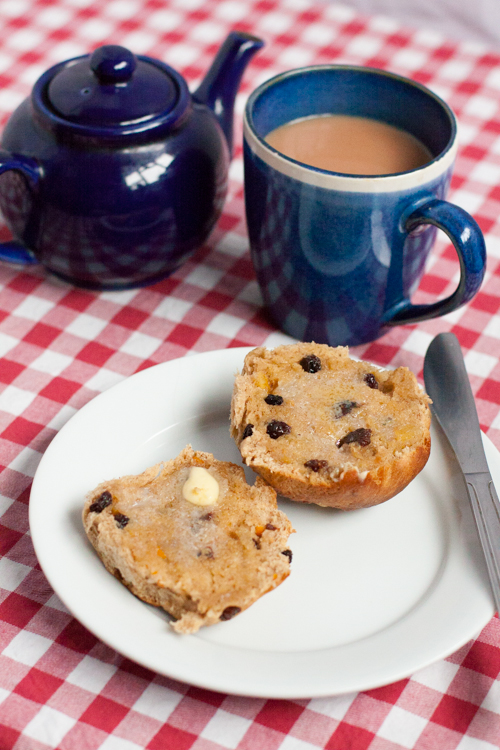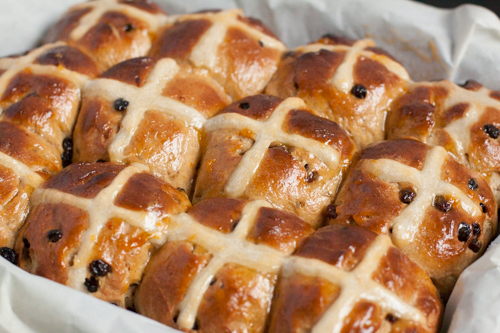
Hot Cross Buns are probably my favourite festive food. The smell of the cinnamon toasting and the taste of them – lightly toasted, thickly buttered – makes me feel all warm and cosy. They are one of my ultimate comfort foods.
I agree with Oliver Thring that “Buns are some of the best things to have emerged from English kitchens”. He gives a potted history of the hot crossed bun. I was interested to discover that the symbology is not Christian in origin – pagans also baked buns and breads marked with a cross. For example, in ancient Greece, breads marked with a cross signified the start of spring; in ancient Egypt, similar delicacies were offered to the goddess of the moon and the Saxons “baked breads slashed with crosses to honour Eostre, their goddess of spring and fertility and the source of our word Easter. The four sections symbolised the four quarters of the moon, or the seasons”.
Thring tells us that Hot Cross Buns became associated with Easter around 1592, when “Elizabeth I restricted London bakeries from making them except at burials, Good Friday or at Christmas." There are a number of superstitions associated with the buns, the most common of which was “that a bun baked on Good Friday would never go mouldy, that if it was hung in the kitchen it would improve a cook's baking and prevent fires from breaking out, and that if you stashed a bun in a heap of corn it would keep the rats and weevils away.”
I try to limit my annual Hot Cross Bun intake to the week before and after Easter, even though they are available for most of the year. I cram as many as possible into that two week window. I've had 7 already, and that's only including one from this batch.
I am a traditionalist. No chocolate, blueberries or cranberries, thank you very much. Just raisins, currants, mixed peel and spice. They didn’t stick around centuries because they weren’t very good. If it ain’t broke don’t fix it!
Makes 12.
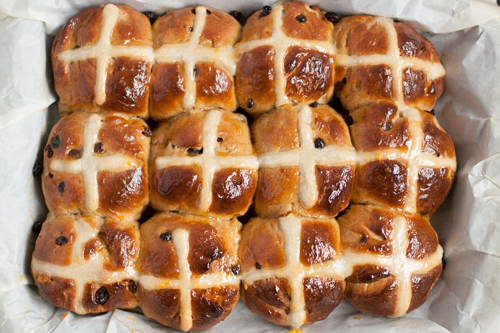
Ingredients
For the dough
450g strong white flour
70g golden caster sugar
Zest of 2 oranges
3 tsp cinnamon
1 tsp mixed spice
½ tsp salt
100g unsalted butter
150ml milk
Pinch sugar
14g instant yeast
2 eggs
Water, as required
150g currants and/or raisins
50g mixed peel
For the cross
4 tbsp plain flour
4 tbsp water
Pinch salt
For the glaze
1-2 tbsp apricot jam
1-2 tbsp water, as required
Method
Sift the flour and caster sugar into a large mixing bowl and add the orange zest, cinnamon and mixed spice. Stir to combine.
Grate the butter into the bowl and use your fingertips to rub into the dry ingredients. Make a well in the centre.
Gently warm the milk over a low heat to 35-45C (body temperature) – use a thermometer, if you have one, or test on the inside of your wrist. Remove from the heat, add a pinch of sugar and the yeast. Leave for 10 minutes to allow the yeast to activate – it should start to bubble on the surface.
Whisk 2 of the eggs and add to the well in the mixing bowl, along with the milk. Use your hands to bring the mix together. You want a soft, pliable dough – not soggy, but not dry or rough either. You can add some warm water to achieve this, if required.
Tip the dough out onto a lightly floured surface and kneed for approx. 10 minutes, until smooth and elastic.
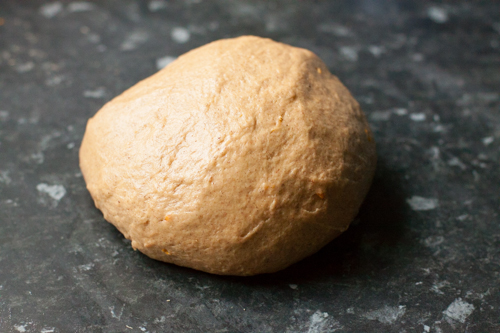
Form a smooth ball with the dough and put in a large, lightly-oiled bowl (not ceramic, too cold). Cover with a tea towel and leave for approximately 2 hours in a warm place to rise, until it has at least doubled in size.
Tip the dough out onto a lightly-floured surface and add the mixed peel, currants and/or raisins bit-by-bit, kneading until fully incorporated.
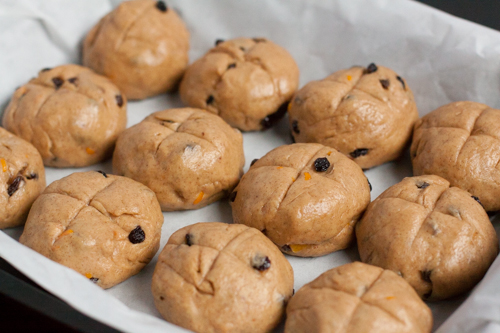
Divide into 12 balls of dough and place on a baking tray lined with baking parchment. They should be reasonably snug, so that when they double in size again they are just touching.
Score a cross in the top of each bun, put the tray in a plastic bag (ensuring that it is not touching the buns) and leave in a warm place for approximately 1 hour or until doubled in size again.
Preheat the oven to 200C. 
To make the paste for the cross, mix the flour, water and pinch of salt together in a small mixing bowl. When the buns have risen, use a piping bag to pipe a cross onto each.
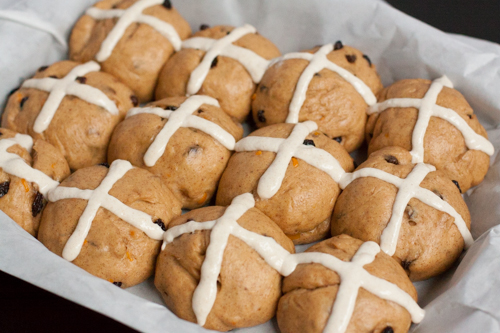
Bake for 20 minutes, or until golden brown.
Gently warm the apricot jam over a low heat, adding a little water if required, to make the glaze. Brush over the warm buns.
Leave to cool on a wire rack or, better yet, eat fresh from the oven with plenty of salted butter (you should be able to see teethmarks).
